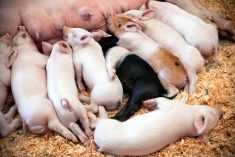RED DEER – Scarce supplies of higher quality forages for dairy cows have forced producers to manage rations more carefully to prevent digestive problems.
Milk production levels can be maintained with low-forage diets but management is crucial, especially when feeding barley grain, said Karen Beauchemin of Agriculture Canada’s research centre in Lethbridge.
She told the western dairy seminar in Red Deer March 13 that the minimum fibre requirement depends on the diet’s fermentability and starch levels. When barley grain is predominant, starch content of the diet should not exceed 35 percent to prevent rumen acidosis.
Read Also

Dennis Laycraft to be inducted into the Canadian Agricultural Hall of Fame
Dennis Laycraft, a champion for the beef industry, will be inducted into the Canadian Agricultural Hall of Fame this fall.
Dairy cows tend to eat high-
energy feed that is low in fibre and high in starch to produce large quantities of milk. However, they still need fibre that stimulates them to chew and produce saliva.
Saliva helps buffer the rumen against acids, making it easier for microbes to digest the feed.
An average dairy cow produces 200-300 litres of saliva per day from eating and chewing cud.
Rumen microbes suffer when the rumen pH is below 5.8.
“When the rumen pH is low, the bugs in the rumen that digest fibre don’t do well,” Beauchemin said.
A high grain diet causes the pH level to drop and produces acid in the rumen. Within a few days the animal does not feel well and does not eat as much.
This problem often goes undetected and consequences are more severe in some animals.
As well, low rumen pH increases the risk of laminitis, resulting in malformation of new claw tissue and making the foot more susceptible to injury and infection.
A higher proportion of barley can be fed when grass or legume forages are provided or when cereal silages are low in grain content. High fibre concentrate feed such as beet pulp, soy hulls, corn gluten, grain screenings and dehydrated alfalfa can replace some barley to reduce starch levels.















